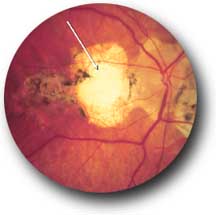Ocular Histoplasmosis Syndrome
Eye Care > Diseases of the Eye > Ocular Histoplasmosis Syndrome
What is Ocular Histoplasmosis Syndrome?
Histoplasmosis is caused by a fungus commonly found in certain dust and soil. It affects men and women equally.
Histoplasmosis is contracted by inhaling dust that carries the fungal spores. Its effect on the body can vary widely in severity from one person to another. Many carriers have no symptoms at all, but those with mild exposure may experience flu-like symptoms and mild respiratory infections. Histoplasmosis is more likely to become a serious problem in people who already have a weakened immune system.
The fungus may affect the eye by causing small areas of inflammation and scarring of the retina. These are called “histo spots” and may be found in both eyes. Their effect on vision depends on the location of the scars. Scarring in the peripheral area of the retina may have little or no impact on vision, while a central scar affecting the macula may cause a prominent blind spot.

Most people with histo spots in the retina are totally unaware of their presence unless the central vision is affected. Studies indicate that only about 5% of those with histo spots are at risk of losing vision. Scientists have been unable find a link between the patients with minor histo spots and those who develop a severe loss of their central vision.
Signs and Symptoms
Many patients with histo spots in their eyes have no symptoms. Others may experience the following:
- Distorted vision
- Blind spots
- Scars in the retina, ranging in severity
Detection and Diagnosis
Ocular histoplasmosis is detected with a dilated pupil examination of the retina using ophthalmoscopy. It is usually diagnosed based on its distinctive appearance and characteristics.
Treatment
Ocular histoplasmosis usually requires no treatment except when abnormal blood vessels develop in the central retina. For these patients, laser treatment may be necessary. In some cases, surgical removal of the tiny, abnormal vessels has been successful.
Regular eye examinations and routine use of an Amsler Grid to monitor central vision is recommended for anyone with histo spots.
Illustrations by Mark Erickson
With acknowledgement to St. Lukes Eye Hospital.
